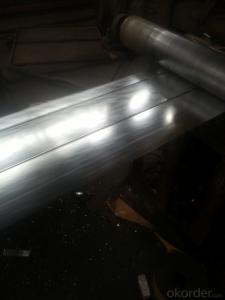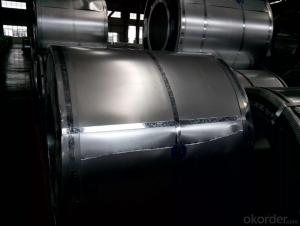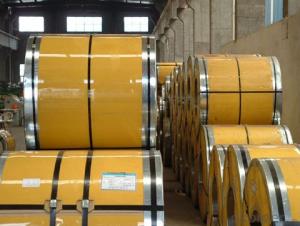Hot Dip Galvanized Steel Strip
- Loading Port:
- China Main Port
- Payment Terms:
- TT OR LC
- Min Order Qty:
- -
- Supply Capability:
- -
OKorder Service Pledge
OKorder Financial Service
You Might Also Like
Product Description:
Galvanized steel strips are widely used in the construction industry, as raw material for the production of corrugated panels, fencing products, drywall panel profiles, ventilation systems etc. Recommended for both outside and inside usage, galvanized steel has a high resistance to corrosion in different environments, due to a protective layer of zinc of 100 –180 grams per square metre.
Hotdip galvanized steel strips are produced by immersing steel in a zinc bath. An appropriate galvanizing process requires a pretreatment process during which the steel passes through different baths which prepare the surface for zinc coating. In this stage, chemicals are used to clean the surface of the steel. After the chemical treatment, the steel coils pass through a bath of melted zinc at temperatures around 460 ° C. The resulting uniform coating is finished through a process of skin-passing to provide smooth and shiny appearance of the finished product. To store for a longer period, the hot-dip galvanized coils can be delivered with a final oil coating, according to the customer’s demand.
Technical specification :
• Steel grade: DX51D+Z• Zinc coverage:30-180 g/sqm on both sides (depending by the requested specification);• Thickness: between 0,2 mm and 1,00 mm;• Width:600mm,914mm,1000mm, 1220mm and 1250 mm;• Coil weight: 4-6 mt;• Coil ID: 508 mm;• Coil OD: 900-1500 mm ;
Depending on their usage, the hot-dip galvanized coil can be delivered slightly oiled.
- Q:Are steel strips suitable for low-temperature applications?
- Yes, steel strips are suitable for low-temperature applications. Steel has excellent strength and toughness properties, which make it highly resistant to low temperatures. It can maintain its structural integrity and perform well under extreme cold conditions, making it a suitable choice for various low-temperature applications such as in cold storage facilities, refrigeration units, and cryogenic environments.
- Q:How are steel strips tested for coating adhesion?
- Steel strips are typically tested for coating adhesion through various methods such as cross-cut tests, pull-off tests, and bend tests. These tests involve assessing the ability of the coating to adhere to the steel surface by subjecting it to different forces and examining any signs of detachment or peeling.
- Q:How are steel strips used in the telecommunications industry?
- Steel strips are commonly used in the telecommunications industry for various applications such as cable shielding, grounding, and structural support. They provide durability and strength, ensuring the protection and stability of telecommunication cables and infrastructure.
- Q:How do steel strips compare to titanium or aluminum strips?
- Steel strips are generally stronger and more durable compared to titanium or aluminum strips. Steel has a higher strength-to-weight ratio, making it capable of withstanding heavy loads and high impact situations. Additionally, steel is more resistant to corrosion and extreme temperatures than both titanium and aluminum. However, titanium and aluminum strips are lighter and offer better conductivity, which may be advantageous in certain applications where weight or electrical properties are crucial. Ultimately, the choice between steel, titanium, or aluminum strips depends on the specific requirements of the intended use.
- Q:How are steel strips processed for surface bending?
- Various methods are employed to process steel strips for surface bending. The initial step in the process involves selecting the appropriate steel grade and thickness for the desired application. Once the steel strips have been chosen, they undergo cleaning and preparation before bending. Roll forming machines are commonly utilized to bend the surface of steel strips. These machines consist of a series of rollers that gradually shape the strip into the desired form. The strip is fed through the machine, and each roller applies a small amount of force, gradually bending the strip. This process enables precise and consistent bending. Another approach to surface bending is press braking. This technique involves the use of a hydraulic or mechanical press to bend the strip. The strip is positioned between a punch and a die, and pressure is applied, causing the strip to bend. Press braking is suitable for both small and large bends, and it allows for the formation of more intricate shapes. In some instances, heat is applied to aid in the bending process, known as hot bending. This method is typically used for thicker steel strips. The strip is heated to a specific temperature and then shaped into the desired form. The heat softens the steel, making it more malleable and easier to bend. Following the surface bending process, the steel strips may undergo additional treatments such as annealing or tempering to enhance their strength and durability. These treatments help to eliminate internal stresses caused by bending and improve the overall performance of the steel. In conclusion, steel strips can be processed for surface bending using various methods, including roll forming, press braking, and hot bending. The selection of the technique depends on factors such as the desired shape, strip thickness, and specific application requirements.
- Q:Can steel strips be used in architectural applications?
- Yes, steel strips can definitely be used in architectural applications. Steel is a versatile and durable material that can be shaped into various forms, including strips, making it suitable for a wide range of architectural uses. Steel strips can be used for cladding, roofing, and siding applications, providing structural support while also enhancing the aesthetic appeal of a building. Additionally, steel strips are often used for decorative purposes, such as creating feature walls or accents, due to their sleek and modern appearance. Overall, steel strips offer architects and designers a flexible and reliable option for incorporating metal elements into their architectural projects.
- Q:What is the typical elongation percentage for steel strips?
- The elongation percentage for steel strips may vary depending on the particular type of steel and its intended use. Generally, steel strips have an elongation percentage ranging from 10% to 25%. This implies that the steel strip can stretch or elongate by this percentage before it breaks. It is worth mentioning that various grades of steel can have different elongation percentages, and the specific elongation requirements may differ based on the industry and the specific application of the steel strip.
- Q:What are the benefits of using pre-painted steel strips?
- The benefits of using pre-painted steel strips include enhanced durability and corrosion resistance, reduced maintenance and painting costs, improved aesthetics, and efficient installation due to the ready-to-use nature of the pre-painted strips.
- Q:What are the different surface finishes available for steel strips?
- There are several different surface finishes available for steel strips, including mill finish, galvanized, polished, brushed, coated, and embossed. Each finish offers unique properties and appearances, allowing for various applications in different industries.
- Q:What are the important considerations for storing steel strips?
- The important considerations for storing steel strips include proper environmental conditions, such as a dry and well-ventilated area to prevent rust or corrosion. It is also crucial to store them in a horizontal position to avoid warping or bending. Additionally, they should be stored away from any chemicals or substances that could damage the steel. Regular inspections and maintenance should be conducted to ensure their integrity and quality.
1. Manufacturer Overview |
|
|---|---|
| Location | |
| Year Established | |
| Annual Output Value | |
| Main Markets | |
| Company Certifications | |
2. Manufacturer Certificates |
|
|---|---|
| a) Certification Name | |
| Range | |
| Reference | |
| Validity Period | |
3. Manufacturer Capability |
|
|---|---|
| a)Trade Capacity | |
| Nearest Port | |
| Export Percentage | |
| No.of Employees in Trade Department | |
| Language Spoken: | |
| b)Factory Information | |
| Factory Size: | |
| No. of Production Lines | |
| Contract Manufacturing | |
| Product Price Range | |
Send your message to us
Hot Dip Galvanized Steel Strip
- Loading Port:
- China Main Port
- Payment Terms:
- TT OR LC
- Min Order Qty:
- -
- Supply Capability:
- -
OKorder Service Pledge
OKorder Financial Service
Similar products
New products
Hot products
Related keywords






























